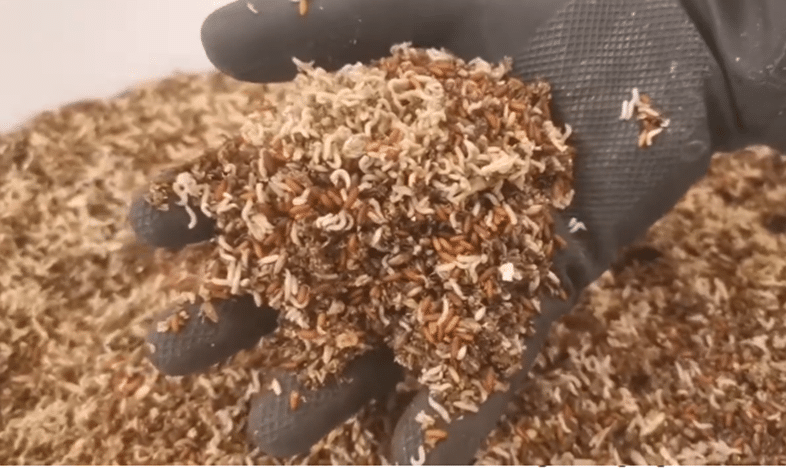To put it in simple terms, biological fly control is the term for the method of using the natural enemies of the flies for keep the population under control. Several insects are so-called beneficial insects and will exterminate other insects such as house flies and biting flies. An example of the is predatory flies and mini wasps, and as such these can be used strategically for example as natural fly control in cattle, pig and horse stables.
Biological fly control is a preventative method for fly control
To make use of biological fly control using predatory flies or mini wasps, it has to be considered a preventative strategy meaning the plan for fly control should be initiated in early spring, as it is important to be aware that you have to start BEFORE the heat of spring and summer arrive.
Spring: Establish an army of beneficial insects in the stable
A small army of predatory flies and mini wasps should be established in the stable, before the unwanted flies show up. In that way you will be ahead of the development and the stable will be ready for deling with the invasion of flies.
Summer: Deploy small portions of beneficial insects in the stable throughout the summer
By deploying portions of predatory flies or mini wasps in the environment of the stable with short intervals in early spring and regularly throughout summer it becomes possible to keep, for instance, the common house fly and the biting fly populations low for all of the fly season.
Biological fly control can be used with great success in pig and cattle stables
In 2014 the Department of Agroecology at Aarhus University wrote Guidelines for control of flies at and around farms with livestock. They have noted the following about biological fly control:
“BIOLOGICAL CONTROL OF FLIES USING PREDATORY FLIES CAN BE USED WITH GREAT SUCCESS IN MANY PIG STABLES WITH SLOTTED FLOORS AND BEDDING. MINI WASPS CAN BE USED WHERE SOLID MANURE GATHERS OVER A LONGER PERIOD SUCH AS IN CALF BOXES AND LARGE AREAS WITH DEEP LITTER BEDDING”
Department of Agroecology (2014)
The larvae of predatory flies eat the larvae of other flies
Predatory flies can be used to control other flies in stables because their larvae are so-called predatory larvae that feed on the larvae of other flies. They are found in the wilds of most of Europe and North America and predatory flies are neither genetically modified nor created by humans.
Predatory flies are effecient against common house flies and biting flies
Predatory flies – in Latin hydrotaea aenescens</em (also known as black dump flies, black garbage flies, and dump flies) are the natural enemies of house flies (Musca domestica) and biting flies (Stomoxys calcitrans), both of which can often be found in pig, horse and cattle stables.
Predatory flies are good for use in stables with slurry channels
As a rule of thumb you can say that predatory flies are really good for fly control in stables with slurry channelse. You can read more about predaty flies at How predatory flies work.
In the below video you can see how Erik Nørbjerg from Thy in Northen Jutland use both predatory flies and mini wasps with his conventional cattle herd.
Mini wasps lay their eggs in fly pupae and take over
Mini wasps is a small group of wasps (2-3mm.) which breed by laying eggs in the pupae of the flies leading to mini wasp larvae instead of flies.
Mini wasps are good for use in stables with deep litter bedding
As a basic mini wasps are good for stables with dry areas such as stables with deep litter bedding.
Place the contained of mini wasps near the area in which you want to get better fly control
Usually, it is enough to place the container with parasitic wasps near the area you to engage in fly control in – for example in a box. In other cases, it is better to spread the wasps along the edge of the box. This depends on the setup of your stable. You can read more about mini wasps on How the mini wasp .
Get a delivery plan from a professional provider of biological fly control
When you choose to use biological fly control in the barn, it is important that you have a plan for deploying the beneficial insects before you start adding them. You want to have them well-established in the stable before spring and the heat that comes with it. This means you need to get a few deliveries early in the year at brief intervals.
You will typically have a delivery plan from the supplies, which tells you when you can expect to have to add a new portion of predatory flies or mini wasps, to keep the number of unwanted flies under control.
The supplier will mail you the beneficial insects when it is time for a new portion. All you have to do is open the box when it arrives at the stable and add them to the environment of the stable.
Sources
- Andersen, Tina (2022) Gyllefluer er hverken genmanipulerede eller menneskeskabte. Miljøfluens Vidensbank om biologisk fluebekæmpelse.
- Agro-Institut for Agroøkologi (2014) Retningslinjer for fluebekæmpelse på og omkring gårde med husdyr. Aarhus Universitet
- Dahlem, Gregory A. (2009) Chapter 125 – House Fly: (Musca domestica). Encyclopedia of Insects (Second Edition), Academic Press. Pages 469-470
- Dansk Landbrugsrådgivning, Landscentret. Fluer – problemer og løsninger.
- Miljøfluen (2022) Gyllefluer. Miljøfluen.dk
- Miljøfluen (2022) Kvægstalde. Miljøfluen.dk
- Miljøfluen (2022) Sådan arbejder gyllefluen. Miljøfluen.dk
- Miljøfluen (2022) Snyltehvepse. Miljøfluen.dk
- Miljøfluen (2022) Sådan arbejder snyltehvepsen. Miljøfluen.dk
- Taylor, David B. (2022) Stable Fly (Stomoxys calcitrans, Muscidae). Encyclopedia of Infection and Immunity. Volume 2, 2022, Pages 903-913



